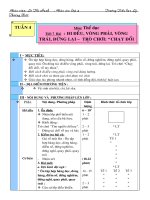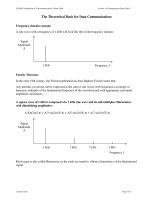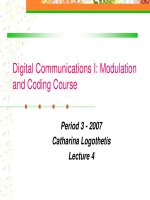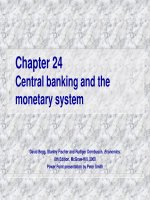Lecture 4 the monetary system
Bạn đang xem bản rút gọn của tài liệu. Xem và tải ngay bản đầy đủ của tài liệu tại đây (2.76 MB, 31 trang )
LECTURE 6:
The Monetary System
Lecture Objectives
The Meaning of Money
•
Money
– Set of assets in an
economy
– To
That
regularly
buypeople
goods and
servicesuse from other people
• The functions of money
– Medium of exchange
– Unit of account
– Store of value
2
The Meaning of Money
•
Medium of exchange
– Item that buyers give to sellers
•
• When they want to purchase goods
and
Unit
of account
– Yardstick
people use to post prices and
•
services
record
debts
Store of value
– Item that people can use to
transfer purchasing power
3
The Meaning of Money
•
Liquidity
– Ease with which an
asset can be converted
into the economy’s
medium of exchange
•
• The kinds of money
Commodity money
– Money that takes the form of a commodity
•
with intrinsic value
Intrinsic value
– Item would have value even if it were
4
The Meaning of Money
•
The kinds of money
•
Fiat money
– Money without intrinsic
value
– Used as money because of
government decree
•
Money in the economy
•
Money stock
– Quantity of money
circulating
in the economy
5
The Meaning of Money
•
Money in the economy
•
Currency
– Paper bills and coins in the
•
public
Demand deposits
– Balances in bank accounts
•
hands of the
• Depositors can access on
demand check
by writing a
Measures of money stock
6
Figure 1
Two measures of the money stock for
economy
The two most widely followed measures of the money stock are M1 and M2. This
figure shows the size of each measure in 2007
7
Where is all the currency?
•
•
2007: $759 billion of currency outstanding
–
Average adult: holds about $3,272 of currency
–
Much of the currency is held abroad
–
Much of the currency is held by drug dealers,
evaders, tax and other criminals
Currency – not a particularly
good way to hold
wealth
– Can be lost or stolen
– Doesn’t earn interest
8
Central Bank and its Functions
•
•
•
•
•
Issue currency
Act as banker to the government
Regulate banks to promote safe and sound
banking practices.
Act as a banker’s bank, making loans to
banks and as a lender of last resort.
Conduct monetary policy by controlling the
money supply.
Central Banks
in Different Countries
•
In USA: The Federal Reserve System (Fed)
•
In Australia: The Reserve Bank of Australia (RBA)
In Vietnam: The State Bank of Vietnam
•
SELF-STUDY
The Central Bank
•
The primary tool - open-market
– Purchase & sale
of the government
bonds
operation
• increase the money supply
– Open-market purchase
• decrease the money
supply
– Open-market sale
14
Banks and the Money Supply
•
Reserves
– Deposits that banks have received but
have not loaned out
•
The simple case of 100% reserve banking
•
All deposits are held as reserves
– Banks do not influence the supply
of money
FIRST NATIONAL BANK
Assets
Reserves
Liabilities
$100.00 Deposits
$100.00
15
Case study
• />2020-01-01/china-cuts-banks-reserve-rati
o-to-boost-economic-growth-in-2020
• />N1kHK7c
• Open discussion
Banks and the Money Supply
•
Money creation: fractional
reserve banking
– Banking system
– Banks hold only a fraction of deposits as
reserves
– Reserve ratio
• Fraction of deposits that banks hold as reserves
• Bank must hold – reserve requirement
•
– Minimum set by the Fed
Bank may hold
additional excess reserves
16
Banks and the Money Supply
•
Money creation: fractional reserve
– Reserve ratio = 1/10
(10 percent,
R)
banking
FIRST NATIONAL BANK
Assets
Reserves
Loans
•
Liabilities
$10.00 Deposits
$100.00
$90.00
Banks hold only
a fraction of deposits in
reserve
– Banks create money
– Increase in money
17
Banks and the Money
•
Supply
The money multiplier
SECOND NATIONAL
Assets
Reserves
Loans
BANK
Liabilities
$9.00 Deposits
$90.00
$81.00
THIRD NATIONAL BANK
Assets
Reserves
Loans
Liabilities
$8.10 Deposits
$81.00
$72.90
18
Banks and the Money
•
Supply
The• money multiplier
Original deposit = $100.00
•
[= .9 × $100.00]
First National lending = $
• 90.00
Second National lending = $ 81.00 [= .9 ì $90.00]
ã
[= .9 ì $81.00]
ã
ã
Third National lending = $
Total money supply = $1,000.00
72.90
…
19
Banks and the Money Supply
•
•
The money multiplier
– Amount of money the banking system
generates with each dollar of reserves
– Reciprocal of the reserve ratio = 1/R
The higher the reserve ratio
– The smaller the money multiplier
20
Banks and the Money Supply
•
The tools of monetary control
1.
Open-market operations
– Purchase and sale of government
bonds
– To increase the money supply
• buys government bonds
– To reduce the money supply
• sells government bonds
– The preferred tool
21
Banks and the Money Supply
•
The tools of monetary control
2.
Reserve requirements
– Regulations on minimum amount of
reserves
• That banks must hold against deposits
– An increase in reserve requirement
• Decrease the money supply
– A decrease in reserve requirement
• Increase the money supply
– Used rarely – disrupt business of
banking
22









